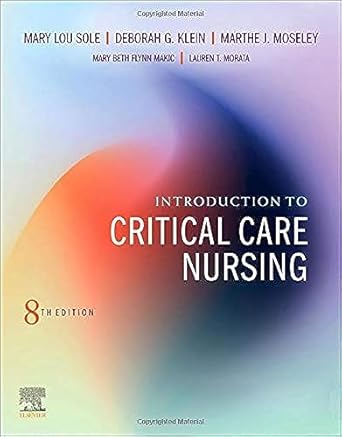Discover the essential resource for mastering critical care nursing with the *Introduction to Critical Care Nursing, 8th Edition*. Selected for Doody’s Core Titles® 2024 in Critical Care, this comprehensive textbook equips nursing professionals with the skills and knowledge needed to deliver safe, effective, and patient-centered care in high-acuity settings. With a focus on evidence-based practices, the book features realistic case studies, quick-reference nursing care plans, and clear organization by body systems, ensuring that you can easily navigate complex information.
Standout features include Critical Reasoning Activities designed to enhance clinical judgment, an emphasis on QSEN competencies to foster high-quality healthcare delivery, and detailed coverage of cardiac assistive devices and infection control. Nearly 300 full-color illustrations clarify key concepts, while new Study Break questions allow for effective self-assessment. Whether you are preparing for the Next-Generation NCLEX-RN® Exam or advancing your clinical skills, this textbook is an invaluable tool for success in today’s demanding critical care environments.
Introduction to Critical Care Nursing
Why This Book Stands Out?
- Core Title Selection: Selected for Doody’s Core Titles® 2024 in Critical Care, highlighting its significance in the field.
- Comprehensive Coverage: Evidence-based content with realistic case studies and the latest advances in critical care nursing.
- Organized Structure: Disorders categorized by body system or special situation, facilitating easier navigation and understanding.
- Critical Reasoning Activities: Promotes clinical judgment development, essential for preparing for the Next-Generation NCLEX-RN® Exam.
- QSEN Competencies: Emphasis on knowledge, skills, and attitudes necessary for high-quality patient care in critical settings.
- Universal Collaborative Plan: Addresses collaborative care for critically ill patients, enhancing interprofessional practice.
- Case Studies: Real-world applications of concepts, challenging readers to apply clinical judgment effectively.
- Clinical Alerts: Highlights potential problems to improve patient safety and care quality.
- Medication Tables: Detailed information on commonly used medications, including actions, dosages, and nursing implications.
- Updated Content: Includes modern equipment illustrations, infection control practices, and enhanced lifespan considerations.
- Study Break Questions: New multiple-choice questions throughout chapters to reinforce understanding and facilitate learning.
- Genetics and Transplant Considerations: Focus on contemporary topics in patient care, including organ transplantation and genetic concepts.
Personal Experience
As I delved into the pages of Introduction to Critical Care Nursing, I found myself reflecting on my own journey in the nursing field. This textbook is not just a collection of facts and theories; it resonates with the real-life experiences that many of us face in high-pressure environments. Here are a few relatable insights that may resonate with fellow readers:
- Real-World Application: The case studies presented throughout the book remind me of the pivotal moments in my own clinical practice where theoretical knowledge met real patient scenarios. Each case study challenges us to apply what we’ve learned, mirroring the expectations we face on the floor.
- Critical Thinking Development: The Critical Reasoning Activities woven throughout the chapters are a great way to sharpen our clinical judgment. I recall moments during my training when I was faced with unexpected patient situations that required quick thinking and sound decision-making.
- Emphasis on Patient-Centered Care: The book’s focus on providing safe, high-quality healthcare strikes a chord with my personal commitment to patient advocacy. It serves as a reminder of the importance of seeing the patient as a whole, rather than just a set of symptoms.
- Collaborative Care Insights: The Universal Collaborative Plan of Care highlighted in the text resonates with my experiences working in interdisciplinary teams. It emphasizes the importance of communication and collaboration, which are crucial in critical care settings.
- Visual Learning: The nearly 300 full-color photographs and illustrations not only clarify complex concepts but also evoke memories of the equipment and procedures I encountered during my own training. Visual aids have always been a helpful tool for my learning style.
- Preparation for Real-Life Challenges: The emphasis on current challenges such as drug-resistant infections and the management of critical care devices speaks to the realities we face today as healthcare providers. It prepares us for the evolving landscape of patient care.
- Support for Lifelong Learning: The updated content regarding aging populations and genetic considerations reinforces the importance of continuous education in our ever-changing field. It inspires me to stay informed and adaptable.
Overall, Introduction to Critical Care Nursing is more than just a textbook; it’s a companion on our journey as nurses, guiding us through the complexities of critical care and reminding us of our vital role in patient outcomes.
Who Should Read This Book?
This comprehensive textbook is designed for a wide range of individuals engaged in critical care nursing and related fields. Its structured approach and evidence-based content make it suitable for:
- Nursing Students: Ideal for those pursuing a nursing degree, this book provides foundational knowledge and critical reasoning skills essential for success in critical care environments.
- New Graduate Nurses: Recent graduates will benefit from the clear explanations and case studies that bridge the gap between theoretical knowledge and practical application in high-acuity settings.
- Experienced Nurses: Seasoned critical care nurses can use this text to stay updated on the latest advances, evidence-based practices, and technologies shaping the field.
- Nursing Instructors: Educators can utilize this resource to enhance their curriculum, providing students with relevant and current information on critical care nursing.
- Healthcare Professionals: Allied health professionals working in critical care settings will find valuable insights into nursing management and collaborative care approaches.
By addressing key aspects of critical care nursing and including real-world case studies, this book equips readers with the knowledge and clinical reasoning skills necessary to thrive in complex healthcare environments.
Introduction to Critical Care Nursing
Key Takeaways
Readers can expect to gain valuable insights and benefits from the comprehensive coverage in Introduction to Critical Care Nursing, 8th Edition.
- Master Critical Care Concepts: Develop a strong foundation in the essential concepts, technology, and procedures crucial for effective critical care nursing.
- Evidence-Based Learning: Engage with realistic case studies and practical applications of evidence-based practice throughout the text.
- Clinical Reasoning Development: Enhance clinical judgment skills with Critical Reasoning Activities designed to prepare you for the Next-Generation NCLEX-RN® Exam.
- QSEN Competencies: Gain knowledge and skills aligned with Quality and Safety Education for Nurses (QSEN) to ensure safe, high-quality patient care.
- Universal Collaborative Care Plans: Utilize a Universal Collaborative Plan of Care that addresses the needs of critically ill patients across various settings.
- Medication and Laboratory Insights: Access detailed medication tables and lab alerts to understand the implications of critical care treatments and assessments.
- Visual Learning Aids: Benefit from nearly 300 full-color photographs and drawings that clarify key concepts and equipment in the critical care environment.
- Study Breaks for Comprehension: Utilize new Study Break questions to reinforce understanding and retention of material in manageable sections.
- Focus on Patient-Centered Care: Explore transplant considerations and palliative care to enhance the quality of care for patients at different stages of treatment.
- Current Trends in Healthcare: Stay updated with the latest advances in critical care, including noninvasive hemodynamic monitoring and infection control strategies.
- Lifespan and Genetics Considerations: Understand the implications of aging populations and genetic factors in patient care through updated Lifespan and Genetics boxes.
Final Thoughts
Overall, “Introduction to Critical Care Nursing, 8th Edition” is an invaluable resource for both nursing students and practicing professionals looking to enhance their critical care knowledge and skills. This comprehensive textbook not only covers essential concepts and procedures but also incorporates the latest advancements in the field, making it a vital addition to any critical care nurse’s library.
Here are some key points that highlight the book’s value:
- Evidence-based coverage with realistic case studies to bridge theory and practice.
- Emphasis on QSEN competencies to ensure high-quality patient care.
- Critical Reasoning Activities that enhance clinical judgment and preparedness for the Next-Generation NCLEX-RN® Exam.
- In-depth coverage of current technologies, including cardiac assistive devices and noninvasive hemodynamic monitoring.
- Nearly 300 full-color illustrations that clarify complex concepts and equipment.
- Updated content reflecting the latest trends and considerations in patient care, including palliative and transplant care.
This textbook is not just a book; it’s a gateway to mastering critical care nursing. Don’t miss the opportunity to elevate your practice and ensure the best outcomes for your patients. Invest in your professional development today by purchasing this essential resource: buy the book now!





